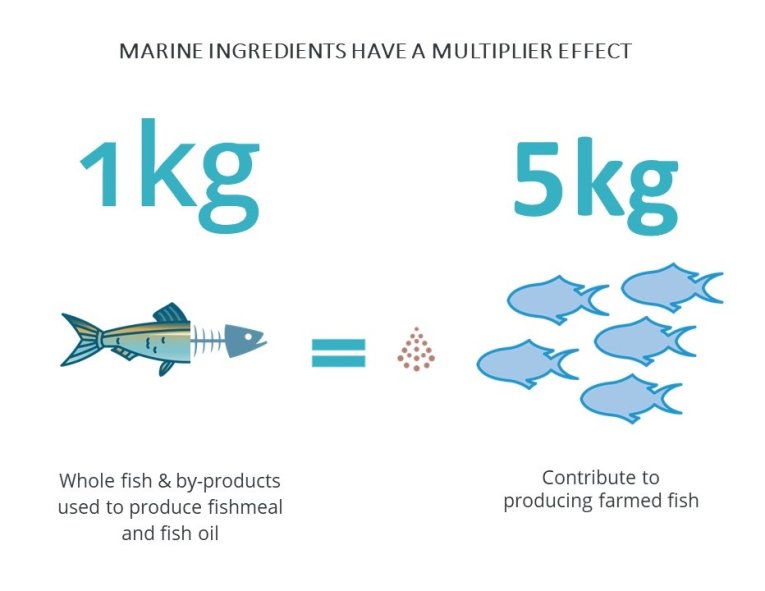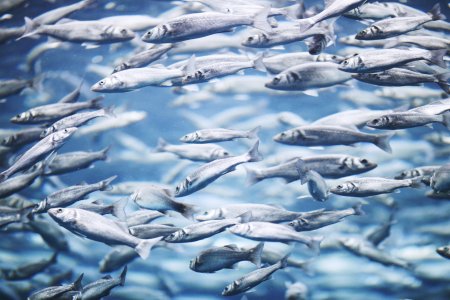The Role of marine ingredients
Explore the role of marine ingredients, how and why they are used, the sources and traceability; and their role in global food security.
What are marine ingredients?
In brief
- Derived from forage fish*, marine organisms such as fish, krill, shellfish and algae
- A growing amount comes from by-products: currently one third of the world’s fishmeal production
- Three quarters of fishmeal and fish oil are used in aquaculture as aquafeed
- Fish oil supplements are widely consumed with around 20% of the total fish oil going to this growing industry
* Forage fish are also known as Small Pelagic fish species. They come from low trophic level fisheries and refer to fast-growing, early-maturing and highly productive species.
Fish eat fish in the wild
Foundation of formulated feed
Fishmeal and fish oil are the foundation of formulated feeds and, because of the superior nutrition that they provide, are regarded as the nutritional benchmark for other ingredients.
The production rates for both ingredients has remained steady for over the past 25 years indicating stability in supply (and consequently no additional pressure on fisheries despite continual aquaculture growth). There is growth in the utilisation of by-products as raw material, but the availability is not enough to match the growth of aquaculture. Aquaculture itself will also provide additional byproduct for fishmeal and fish oil production in the future.
Additional ingredients are being developed alongside fishmeal and fish oil to provide optimal fish nutrition and ensure the continued growth of the aquaculture industry.
Watch Luisa Valente (University of Porto) to better understand the future of protein sources and how marine ingredients compare.
Quality feed means quality food
Marine ingredients provide essential nutrients for human health, indirectly through the farmed animals that we eat and directly through the consumption of fish oil capsules. Just as fishmeal and fish oil play a vital role in the growth and health of farmed fish, these essential proteins, fats, minerals and vitamins are then passed onto humans. For humans, fish provides energy and is a superior source of protein to other animal source foods in terms of total protein and essential amino acid content and digestibility. Among other nutrients, farmed fish are a rich source of vitamin D and calcium (bone and muscle health), vitamin B12 (aids metabolism), Zinc and Selenium (aids immune system).
The other key nutrient for human health in marine ingredients are the long chain omega-3s (EPA and DHA), which are crucial for the health and growth of the farmed animals and in turn pass on the significant health benefits to us. Fish oil supplements are widely consumed with around 20% of the total fish oil produced in 2022 going to this growing industry. It is recommended that healthy adults consume a minimum of 250–500 mg combined EPA and DHA each day as part of a healthy diet.
Committed to Responsible Supply Chains
The marine ingredients industry has a complex but well known supply chain with a well-developed series of certification and improvement schemes. With the wealth of data and information extending over many years, the industry can ensure the continued production of high quality feed and nutraceutical ingredients.
Feeding a growing population

Source: Kok et al., 2020 [https://doi.org/10.1016/j.aquaculture.2020.735474]
- High productivity: For the last 25 years, the production of fishmeal and fish oil has been relatively stable at approximately 5 million tonnes of fishmeal, and 1 million tonnes of fish oil. Supply has not increased alongside the increased need for aquafeed volume.
- Multiplier effect: 1kg marine raw material gives 5kg farmed fish across global production systems. Thus, fish which do not have a food market are converted into 5 times the volume of fish that people do want to eat.
- Decreasing impact on ecosystems: 1/3 of fishmeal is now produced from by-products that are left over after fish from food have been processed
Marine ingredients provide unrivalled and essential nutrients to farmed seafood, most importantly in early stages of growth. The sources of marine ingredients are often from fish that don’t have a strong food market and this valuable resource can instead be processed in fishmeal and fish oil to further contribute to global protein production, food security and farmed animal and human health. Traditionally fishmeal and fish oil provided the foundation of aquafeed, but due to the finite supply of this essential resource, they are now used strategically to ensure the continued health of the fish.
Unused resources have the potential to feed the world
Marine ingredients play a vital role within the global food supply chain, with the majority coming from forage fish, that have a very limited direct food market, and by-products, trimmings from processed fish. Forage fish, such as Peruvian Anchovy, tend to be fragile fish that deteriorate quickly and therefore have limited storage and transport options for the food market. They tend to have a distinct strong flavour making them relatively unpalatable in comparison to other local fish and are therefore consumed in comparatively small quantities. Once processed into fishmeal and fish oil, they can be used strategically in aquatic diets to produce many more times the volume of more widely accepted and consumed fish and other animal protein in a very efficient way. The volume of production of fishmeal and fish oil from Peruvian anchovy is equivalent to the requirement of 50% of the world’s fed farmed fish production, thereby having a significant positive impact on global food security.
However, with a finite supply of forage fish, the increasing use of by-products is providing an essential additional raw material source that through the production of fishmeal and fish oil supports the increased volume of feed required for the fast growing aquaculture industry. By-products are the trimmings of fish from processing for direct human consumption, for example heads, frames, skin and tails. This material may constitute up to 70% of fish and shellfish after processing (fish fillet yield is species-dependent and is often in the range of 30 -50% of the fish). The main source of the by-product is from finfish such as white fish trimmings (pollock, cod, hake, haddock and others) as well as salmon (wild and from aquaculture), tuna, herring, mackerel and can come from wild caught fish or aquaculture processing.
This is a valuable raw material which would otherwise be unused, incurring both economic and environmental costs for disposal. As a raw material source, this material is still underutilised and it is calculated that currently around 33% of global fishmeal production and 51% of global fish oil production comes from by-product. Developing and optimising the collection and processing of this valuable source of raw material should be encouraged as much as possible.
Marine ingredients value chain
Look at our animated infographics below and download the pdf version from the right hand side column. These materials clarify and emphasise the various checks and certifications that the fish feed supply chain has in place.
- Marine ingredients play an essential role in global food security, consumed either by the animals that we eat or through fish oil capsules (health food supplements and pharmaceuticals).
- The raw material of marine ingredients comes from natural resources.
- The production process for fishmeal and fish oil only removes water, and is conducted through processes that after decades of innovation are directed towards protecting the full nutritional qualities of the materials.
In feed, fishmeal and fish oil are a balanced, highly digestible and palatable feed ingredient, which are used at strategic stages of the production cycle of animal in support of growth and health. The properties found in fishmeal and fish oil provide key health benefits to the farmed animals, such as optimal immune system function. While fishmeal and fish oil remain the foundation of aquafeed and continue to be an essential ingredient, the finite supply of these ingredients has led to the increasing use of additional raw materials (soya, wheat and land animal proteins). With the aquaculture industry expected to continue to grow to meet future nutritional needs, both marine ingredients and additional raw materials (including algal products, microbial proteins, insect meal) will be needed to meet this growing demand.
Direct use of fish oil in human foods and capsules is an increasingly significant outlet – the so-called ‘nutraceuticals’. The daily recommended intake of long-chain omega-3 fatty acids, especially EPA and DHA, of 250 to 500 mg can then be met through fish oil supplements.
A detailed value chain can be seen below, showing the different certification standards at each stage.













